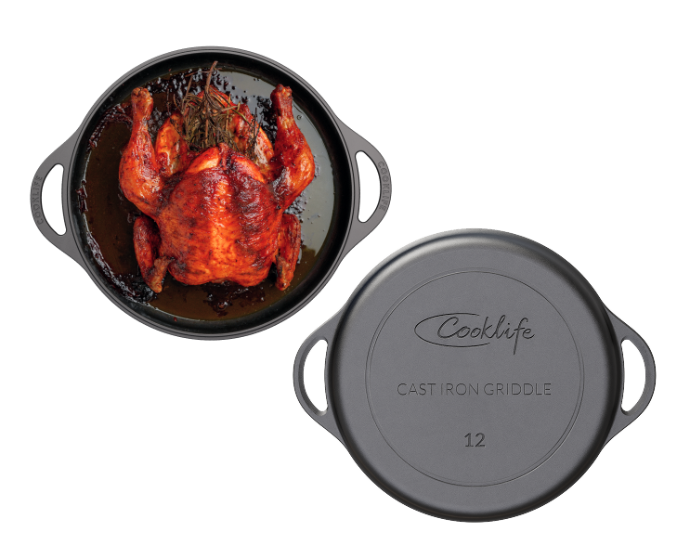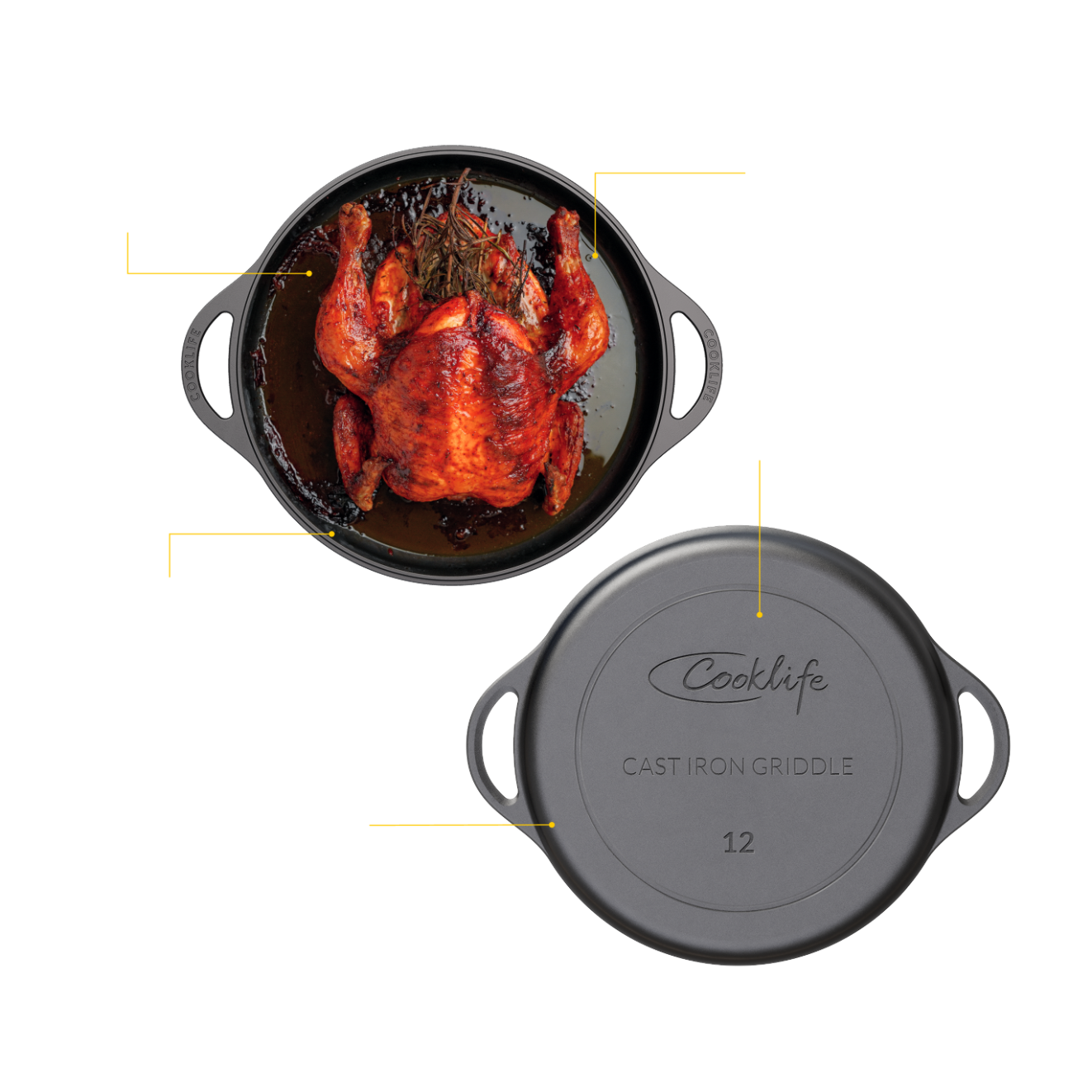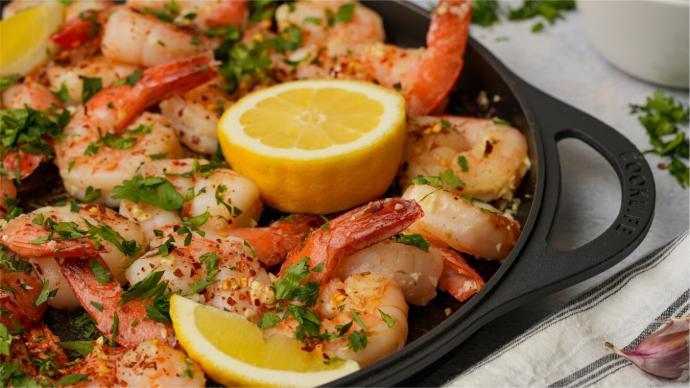
This is very useful when I make breakfast. Frying bacon and sausage is easy. It is great for sauting vegtebles. It is easy to clean and it comes with a mesh dishcloth that aids with keeping cleaning.
— valyoung40
- This is a pre-seasoned cast iron griddle, and it is made of 100% cast iron.
- It is easy to use with the smooth surface and lightweight for every daily meal.
- Oven-safe & enhance flavor. Non-stick & anti-rust. Air dry & maintenance-free.

Concentrated heat transfer paths are shorter and unparalleled insulation reduces heat loss for perfect sear.

Efficient heating and heat retention, you save energy every time you cook.

Lightweight and compact yet powerful, it easily handles your daily cooking needs and fits in any kitchen space.


Customers love our cast iron pot light, smooth, easy maintenance, use to realize that the cast iron pot can be so easy.


This is very useful when I make breakfast. Frying bacon and sausage is easy. It is great for sauting vegtebles. It is easy to clean and it comes with a mesh dishcloth that aids with keeping cleaning.
— valyoung40
Cast iron cookware can develop rust when exposed to moisture for extended periods of time. However, rusting does not make it harmful in any way. If you leave your cast iron cookware in the sink to soak, put it in the dishwasher or let it air dry, it will rust. Moisture-prone environments such as a cabinet near a dishwasher, an open cabinet in a humid location, or outdoor storage can also cause rusting.
Follow these steps to restore your cast iron skillet.
Step 1. Scour
To prepare your cast iron cookware for re-seasoning, start by scouring its surface with warm, soapy water and a metal scouring pad. This is perfectly safe since you will be re-seasoning the cookware anyway. Once you are done, rinse it thoroughly and dry it by hand.
Step 2. Oil
Apply a thin layer of oil inside and outside the cookware. Using too much can cause stickiness.
Step 3. Bake
To achieve the classic black patina on your cookware, place it upside down on the top rack of your oven. Cover the bottom rack with aluminum foil to catch any excess oil that may drip off the cookware. Bake at 450-500 degrees Fahrenheit for one hour. After baking, allow it to cool before repeating the process as necessary.
Sometimes, food can stick to your cast iron cookware. This can occur due to several reasons, including inadequate use of fat or oil during cooking, use of poorly seasoned cookware, or usage of new cookware that hasn't developed extra layers of seasoning yet.
To prevent food from sticking to your skillet, add a teaspoon of oil before cooking and heat it gradually on the stovetop or in the oven. Once you're done cooking, let the cookware cool down and remove any stuck-on food using a pan scraper. Then, scrub the skillet with a nylon brush or non-scratch pad, dry it by hand, and apply a generous layer of oil. Make sure to rub the oil evenly onto the pan.
Black specks may appear on a pan when the seasoning breaks down, but it is harmless and can be avoided with proper seasoning.
To prepare your cookware, gently scrub off any loose flakes, then season it by applying a thin layer of oil and rubbing it all over the pan. Preheat the oven to 450-500 degrees F. Place the cookware upside down on the middle rack of the oven and bake for one hour. Make sure to line the bottom rack with aluminum foil to catch any excess oil. With each seasoning, the flakes will decrease until they are minimal.
It is possible for some seasoning residue to come off your seasoned cookware. This residue is not harmful and will gradually decrease over time as you use the cookware more frequently. You may also notice it when cooking liquids or boiling water, using soap on newer cookware, or cooking acidic and alkaline foods like beans and tomatoes.
By continuing to use and maintain your cookware, the black residue will gradually decrease as the seasoning improves.
If your pan is sticky, it may have excess oil.
To eliminate stickiness, place the cookware upside down on the top rack of the oven and bake at 450-500 degrees Fahrenheit for an hour. Afterward, allow the cookware to cool and repeat the process if necessary.
You may notice lingering smells when cooking fish or spicy foods in cast iron or not cleaning cookware before storing.
If you want to get rid of any unpleasant odor from your cast iron pan, you can simply bake it in the oven at 400 degrees Fahrenheit for 15 minutes. This easy technique will not only help to eliminate the odor, but also protect the seasoning on your cookware. Alternatively, you can sprinkle a layer of regular table salt on the cooking surface of your cookware and leave it on overnight. Rinse it off in the morning and the odor will be gone. If the unpleasant smell still lingers, then you may have to scour and re-season your cookware.
3-Step Cast Iron Cleaning Method
Step 1. Wash
It is important to wash your cast iron cookware by hand. You can add a small amount of soap if desired. If any food is stuck, use a pan scraper to remove it. In case of stubborn, stuck-on food, simmer a little water for 3-5 minutes, and then use a scraper to remove the food after the pan has cooled down.
Step 2. Dry
Make sure to dry the surface completely and promptly using a lint-free cloth or a paper towel. If you see black residue on your towel, don't worry. It's normal seasoning.
Step 3. Oil
Rub a thin layer of cooking oil onto the cookware surface. Use a paper towel to remove excess oil.
There are two ways to maintain the seasoning on your cast iron skillet. The easiest way is to cook with it. Every time you cook with oil, you're potentially adding another layer to the seasoning.
When you cook acidic foods, use excessive heat, or scrub your pan with abrasive utensils or scouring pads, it may remove some of the seasoning. Therefore, it is important to follow our simple cleaning steps to maintain the seasoning for quality cooking. After each use, rub oil into your pan to ensure that the seasoning remains intact.
Did you know that you can improve the seasoning of your cast iron cookware by seasoning it in the oven?
This method ensures that the entire pan has a thorough layer of seasoning which strengthens the bond to the iron. It's advisable to season your cast iron in the oven a few times a year to keep it in great condition. We recommend oven-seasoning when restoring a rusty cast iron pan.
Step 1. Scrub your pan
Scrub the pan with warm, soapy water; it's fine to use soap since you're preparing to re-season the cookware. Rinse and dry thoroughly by hand.
Step 2. Apply oil
Apply a thin, even layer of oil inside and outside the cookware. Using too much oil can cause stickiness.
Step 3. Bake for 1 hour
Place the cookware upside down in the oven on a large baking sheet or aluminum foil on the bottom rack. Bake at 450-500 degrees F for one hour and let cool.

To install this Web App in your iPhone/iPad press
![]() and then Add to Home Screen.
and then Add to Home Screen.